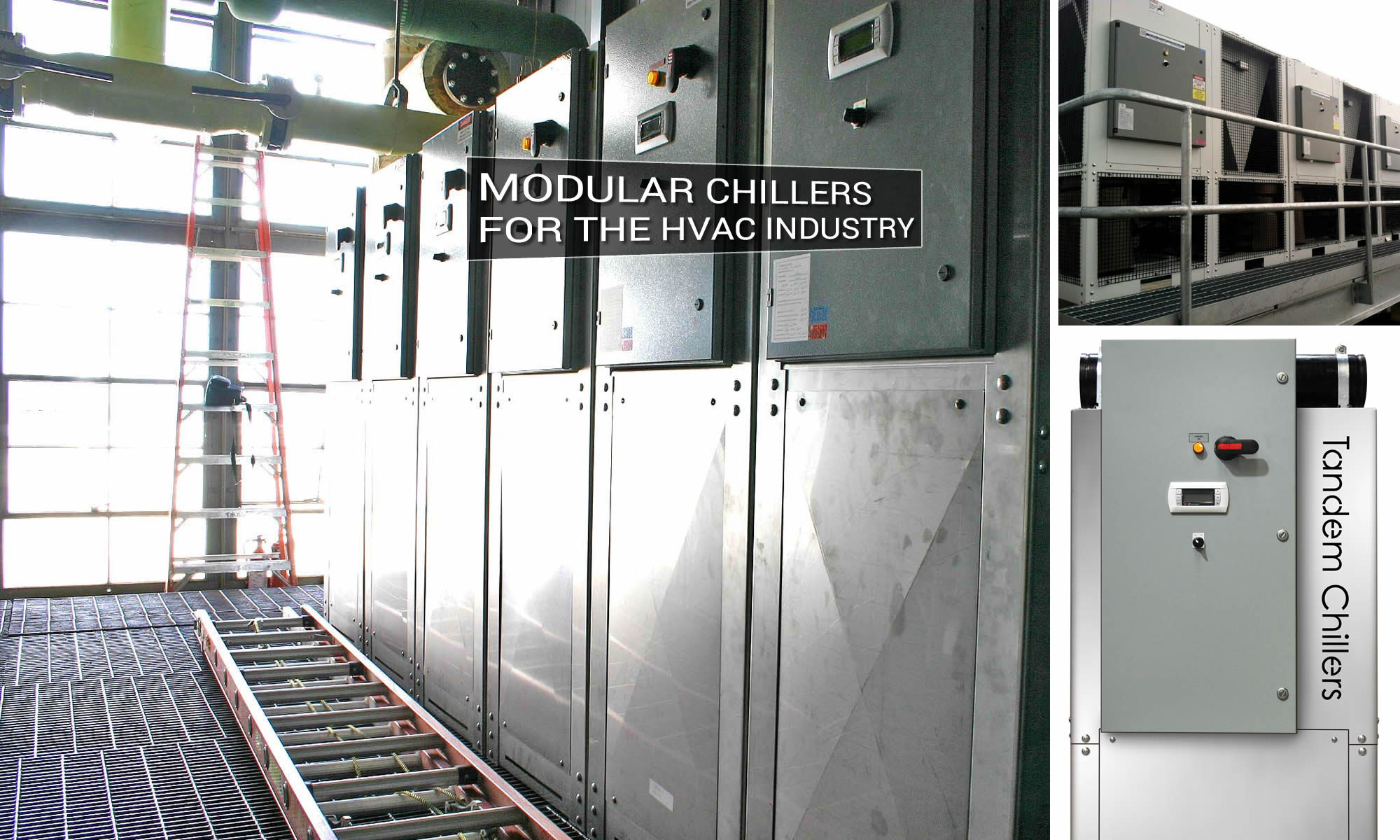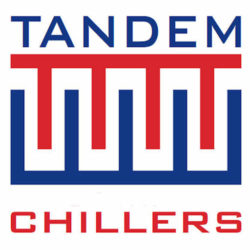Like a lot of advancements in engineering, modular chillers are an outcome of the desire to control the environment around us. As one of the top ten engineering achievements of the 20th century, the air conditioner is a consequence of our search for a way to keep things cool independently of the surrounding environment.
Beyond mere convenience, air conditioning not only protects food and medicines from bacterial decay, it protects electronics, and plays an important role in the delivery of health care. Air conditioning has its roots in the principles of mechanical refrigeration which can be traced to our efforts to cool things like food. In earlier times we collected snow and ice and stored it in caves and cellars to refrigerate food. In the 18th century we collected ice in the winter, packed it in salt wrapped it in strips of cloth and put it into icehouses or cellars to keep it frozen until the summer. In North America we stored blocks of ice in wooden “ice boxes” lined with tin or zinc and insulated with various materials including cork and sawdust.
Mechanical Refrigeration
It wasn’t until the industrial revolution of the 17th and 18th centuries that our search for a method of refrigeration starts to coalesce around several popular theories. Mechanical refrigeration is the culmination of several competing methods: vapor evaporation or, absorption, compression and cold-air systems like the first ice machine built and patented in 1851 by the American Dr. John Goorie.
Five Basic Refrigeration Techniques:
- Ice box (or dry ice box)
- Cold air systems
- Vapor-compression: the current standard method of refrigeration
- Vapor-absorption: the Electrolux refrigerator with no moving parts
- Thermoelectric
If we start with the thermometer by Galileo in 1597, the development of the temperature scale in 1709 by Gabriel Fahrenheit, and the separation of gases in 1773 by Joseph Priestly, we can see the early stages of mechanical refrigeration. Once natural philosophers noticed things like the ability of ether to freeze water when it evaporates and that you could absorb heat by applying pressure to certain gases, the basis for the refrigeration research was set in stone.
Pioneers in refrigeration included people like Dr. William Cullen (1748), who developed the method of evaporative cooling where heat is absorbed by the process of water or vapor evaporation. Other inventors like Oliver Evans (1805) designed the first closed circuit refrigeration machine, while Jacob Perkins (1834) and the famous chemist Michael Faraday (1824) discovered that you could absorb heat by pressurizing a gas like ammonia into a liquid. German engineer Carl von Linden patented the process of liquefying gas in 1876 setting the stage for the modern refrigerator, freezer, air conditioner and dehumidifier.
Very little ice was actually produced until the early 1890s. The first mechanical refrigerator appeared around 1910. J.M. Larsen produced a manually operated machine in 1913. By 1918 Kelvinator introduced the first automatic refrigerator for the American market. They sold 67 models that year. Frozen food was here to stay in 1923 marking the beginning of the frozen food industry.
Mechanical refrigeration uses the method of evaporative cooling. We are all familiar with the cool feeling we get when we put water on our skin. As the water evaporates, it absorbs heat, creating a feeling of coolness. Other fluids like rubbing alcohol can absorb more heat because it evaporates at a lower temperature. In a classic refrigeration system, when a liquid or refrigerantlike ammonia or freon is compressed into a gas, heat is released which is condensed into a liquid by a condenser. This liquid enters the refrigerator and passes into an evaporator, where it’s allowed to expand into a gas and it absorbs heat from its surroundings. The gas then returns outside the refrigerator to repeat this cycle over and over again.
There are four basic parts of the mechanical refrigeration system:
- Compressor – compresses the refrigerant vapor.
- Condenser – releases heat from the refrigerant.
- Expansion Valve – releases vapor refrigerant when needed.
- Evaporator – cold liquid from the expansion valve absorbs heat.
Very little has changed in the refrigeration industry since vapor evaporation and gas compression systems became the norm. Most of the work in the 20th century has concentrated on refining the closed cycle of evaporation, compression and condensation, i.e., finding the most efficient refrigerant, developing better compressors, and working out the most efficient arrangement of components and pressures for the desired operating temperatures.
For more information about refrigeration:
History of Sealed Refrigeration Systems
How Refrigerators Work
Refrigerators – The Physics Handbook
The History of the Refrigerator
The Impact of Refrigeration
Air Conditioning
1902 – Willis Haviland Carrier (the father of air conditioning) figures out the relationship between temperature, humidity and dew point while contemplating the fog on a train platform in Pittsburgh.
1906 – Stuart Cramer is the first to use the phrase “Air Conditioning”. Carrier patents his first device “An Apparatus for Treating Air’ (U.S. Pat# 808897).
1911 – air conditioning becomes a recognized branch of engineering. Carrier presents his basic Rational Psychrometric Formulae to the American Society of Mechanical Engineers. Industries flourish with the new ability to control the temperature and humidity levels during and after production. Film, tobacco, processed meats, medical capsules, textiles and other products acquired significant improvements in quality with air conditioning.
1915 – Carrier and six other engineers form the Carrier Engineering Corporation with a starting capital of $35,000 (Sales in 1995 exceed $5 billion).
1920 – air conditioning is achieved by using larger sizes of extended surface fin and tube heating elements or coils with cold well water to cool theatres and department stores.
1921 – Carrier patents the centrifugal refrigeration machine. The centrifugal chiller was the first practical method of air conditioning large spaces. Previous refrigeration machines used reciprocating-compressors (piston-driven) to pump refrigerant. Carrier’s solution was a centrifugal-compressor similar to the centrifugal turning-blades of a water pump. The result is a safer and more efficient chiller.
1922 – movies are watched for the first time in an air conditioned movie theatre.
1930 – General Electric manufactures and sells 30 self-contained room air conditioners.
1931 – Freon-12 is registered as a refrigerant.
1938 – the centrifugal compressor is introduced by Trane. This was the forerunner of the modern water chiller which combined a centrifugal compressor, condenser, and evaporator into a single unit.
1945 – Refrigerant R-13 is registered.
1950 – sales of room air conditioners surpass 100,000 and never looks back. Refrigerant R-500 is introduced and the father of air conditioning Willis Carrier dies.
For more information about air conditioning:
History of Air Conditioning
Greatest Achievements – 10. Air Conditioning and Refrigeration
Air Conditioning and Refrigeration Institute – Air Conditioning
North American Technician Excellence
How an Air Conditioner Works
Refrigeration Service Engineers Society
Chilling
Like the household refrigerator, the chiller is based on a method of compression. When a refrigerant is compressed, its state will change to either liquid or vapor. This change in state causes the refrigerant to absorb or discharge heat. This gives the chiller system two pressure points: the evaporation (low pressure) and condensing (high pressure) point. Chillers are categorized according to size (portable, central) and by condenser (air or water). At the center of any chiller is the compressor which is either a reciprocating, scroll or screw compressor.
1950 – the first industrial chiller is designed for use in the plastics industry.
1957 – the first rotary compressor is manufactured replacing the less efficient reciprocating compressor allowing for the construction of small, lighter and quieter chillers.
1959 – the American Society of Air Conditioning Engineers merges with the American Society of Refrigeration Engineers to form ASRHAE.
1963 – York installs a central chilling system in the Library of Congress which supplies chilled water totaling 17,000 tons of refrigeration.
For more information about chillers:
American Society of Heating, Refrigeration and Air Conditioning Engineers
Modular chillers
The modular chiller solves several overwhelming concerns in modern day air conditioning. Research has shown that most existing chiller installations are far from energy efficient. Most are at least 30% oversized or more which results in higher than necessary power and energy consumption per ton of cooling delivered, increased maintenance cost and, ultimately, a shortened chiller operating life. The problem is that most of these existing installations are in hard-to-reach areas making maintenance and repair difficult in older deteriorating buildings where footprint space is at a premium.
These problems called for an energy efficient system of air conditioning, that could be installed in hard-to-reach places, was reliable, easy to repair, required a small footprint, and made future expansion easy.
The concept of modular cooling was instigated by the concept of modular heating with modular boilers supplying hot water heating to hi-rise residential buildings where the upper and lowest floors had the maximum heat loss.
1992 – a new filtration system is designed in response to the problem of fouling caused by the use of CBEs (Compact Brazed Heat Exchangers).
2000 – while existing modular chillers are “modular” in the sense that they can be delivered in sections and assembled on site, they guarantee uninterrupted operation by installing additional modules that will back up the system in case one of its individual modules fails or breaks down. This solution is expensive and wasteful compared to a modular chilling system where it is possible to “pull” a component from the system (in order to fix it) and “plug” it back into the system without shutting down the system.
2004 – Tandem Chillers designs the first true modular chiller where it is possible to remove an individual component to fix it and “plug” it back in without shutting down the balance of the system – in a matter of a few hours.

